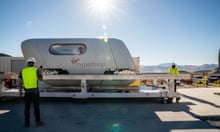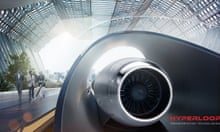The longest hyperloop test track in Europe has opened, raising faint hopes once more that the maglev meets vacuum tube transport technology could be the future.
Operators said the facility would help prove the hyperloop’s feasibility, saying it could allow a 6,200-mile (10,000km) network of high-speed tubes to be in place around the continent by 2050.
As it stands, the European Hyperloop Center test bed in Veendam is not so much a loop as a 420-metre-long forked white pipe running alongside the railway and road that must still be used, for now, to transport people around this corner of the Netherlands.
Made of 34 interconnected prefabricated 2.5-metre-wide steel cylinders, the partly EU-funded test pipe is somewhat shorter than the 2-mile track envisaged in 2020, and allows speeds of only a fraction of the 620mph (1000km/h) that proponents believe the technology can achieve.

The fork in the Vandeem pipe will allow engineers to test what happens at a “lane switch” when a high-speed vehicle changes course. First tests will be carried out by the Dutch company Hardt Hyperloop in the coming weeks.
The centre’s director, Sascha Lamme, said it was a “pivotal moment”, telling Agence France-Presse: “You need this to create a network. The lane switch is a diverging part of the infrastructure, so one part goes for example to Paris, the other one heads off to Berlin.”
after newsletter promotion
The idea of the hyperloop was floated by Elon Musk in 2013, who proposed a line linking San Francisco and Los Angeles, using magnets to propel shuttles along pipes in near-vacuum conditions, with the lack of friction and air resistance potentially allowing the vehicles to rival the speed of aeroplanes.
His fellow tycoon Richard Branson continued to put the hype in hyperloop with a Virgin-branded company testing a passenger capsule in the Nevada desert in 2020. He sold up and the renamed Hyperloop One collapsed last year.
While past predictions for the hyperloop have appeared unduly bold, Lamme maintained a pan-European network could appear in a few decades. “If you look at how highways were developed over time, it goes exponentially when the technology is ready. It should really be possible to get into a station in Amsterdam and travel to a city like Barcelona in two hours.”
Supporters say the hyperloop offers potentially cleaner and quieter as well as quicker transport, although passengers may balk at the idea of travelling in a windowless pod hurtling through an airless tube. Lamme suggested reluctance could be overcome with “a capsule with a nice ceiling which might display stars or a nice sunny day”.
Europe’s innovation may yet allow it to keep up with developments in China, which opened a one-mile test track for “low-vacuum pipeline magnetic levitation technology” in Shanxi province in 2022, according to state media.








